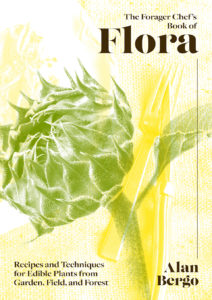Review of: “The Forager Chef’s Book of Flora” by Minnesota Chef Alan Bergo
As another Iowa winter gives way to sunny days, budding trees and migrating birds, we are again reminded that the land provides us with all we need. We are excited to smell spring wildflowers, watch pastures and cover crops turn to green and plan our gardens.
Alan Bergo’s “The Forager Chef’s Book of Flora: Recipes and Techniques for Edible Plants from Garden, Field, and Forest” has been, for me, a welcome addition to these cool, windy days – and a reminder that in the not-too-distant past, food came not from a grocery store but from an unimaginably productive landscape that fed people for thousands of years. Alan’s moniker, the forager chef, is one he has earned. He put his time in on the cook line, worked his way up to be head chef of several restaurants and has tacked on the miles in wild places, rediscovering flavors and broadening the mainstream definition of local food. What started off as a website resume has turned into a full-time job bridging the gap between foraging and culinary art.
Alan’s writing is clear, personal and engaging. His recipes are uncomplicated, and his words instilled in me a confidence to try new methods of cooking and preparing food, both wild and cultivated (try Spring Green Dumplings). I appreciate the simplicity of his recipes, how they highlight fresh ingredients and offer substitutions for inexperienced foragers. I found myself re-envisioning uses for wild plants I have been eating for nearly a decade, and look forward to trying preservation methods that are both novel and simply executed with the resources I currently have.
For example, the book includes eight recipes for common milkweed (Asclepias syriaca), a plant we’ve all gotten to know thanks to recent efforts undertaken to encourage the monarch butterfly. A favorite section of mine highlights hickory nuts and acorns; both are versatile and locally abundant in Iowa’s river valleys. If I could recommend one recipe from this book to make a forager out of anyone, it would be the Hickory Nut Milk Ice Cream. You won’t regret the effort you put into producing this extraordinary dessert.
Just as this book introduces the reader to new wild foods, it also highlights overlooked and misunderstood parts of our cultivated vegetables and landscaped yards that are edible and unique. Who knew you could use tomato leaves as a spice? Why wait to harvest a butternut squash in the fall when you can cook them green, harvest and prepare the growing vines or pickle the flower buds? Like sunflowers? Let’s explore cooking a whole head like an artichoke. Think the deer are eating your hosta shoots because they’re hungry? Well, it’s also because they are delicious seared in a cast iron skillet.
In addition to exposing the reader to new uses for wild and cultivated foods, Alan gives a light commentary on our relationship with garden “weeds.” Across the world, these plants (purslane, lambsquarters, amaranth, mallow, dandelion, burdock, etc.) are seen as welcome volunteers and ingredients in traditional dishes. These commonly encountered species are the perfect bridge between cultivated and wild food, and a gateway to experimenting with foraged ingredients.
“The Forager’s Book of Flora” is clearly defined as a resource for “recipes and techniques,” not as a guide for identifying plants. I am grateful for this, as it keeps the book accessible and easy to digest by the inexperienced botanist. It provides just enough information to encourage readers to pursue their own studies. I also appreciate that Alan’s writing uses both common and scientific names, the only responsible way to effectively communicate to the reader which plants are being used.
This book would be well received by the backyard gardener and professional chef alike. I will be using it as a resource for years to come.
Ben Hoksch lives in Ames, Iowa, at Onion Creek Farm with local food purveyors Lonna Nachtigal and Joe Lynch. He is an ecologist, Iowa enthusiast, local food provider and foraging instructor. Ben can be contacted through his website: ephemeralmidwest.com.
More about “The Forager Chef’s Book of Flora”
288 pages
Published: June 2021
Synopsis: In “The Forager Chef’s Book of Flora” you’ll find the exotic to the familiar—from Ramp Leaf Dumplings to Spruce Tip Panna Cotta to Crisp Fiddlehead Pickles – with Chef Bergo’s unique blend of easy-to-follow instruction and out-of-this-world inspiration.
Over the past 15 years, Minnesota chef Alan Bergo has become one of America’s most exciting and resourceful culinary voices, with millions seeking his guidance through his wildly popular website and video tutorials.
Bergo’s inventive culinary style is defined by his encyclopedic curiosity, and his abiding, root-to-flower passion for both wild and cultivated plants.
Instead of waiting for fall squash to ripen, Bergo eagerly harvests their early shoots, flowers, and young greens—taking a holistic approach to cooking with all parts of the plant, and discovering extraordinary new flavors and textures along the way.


